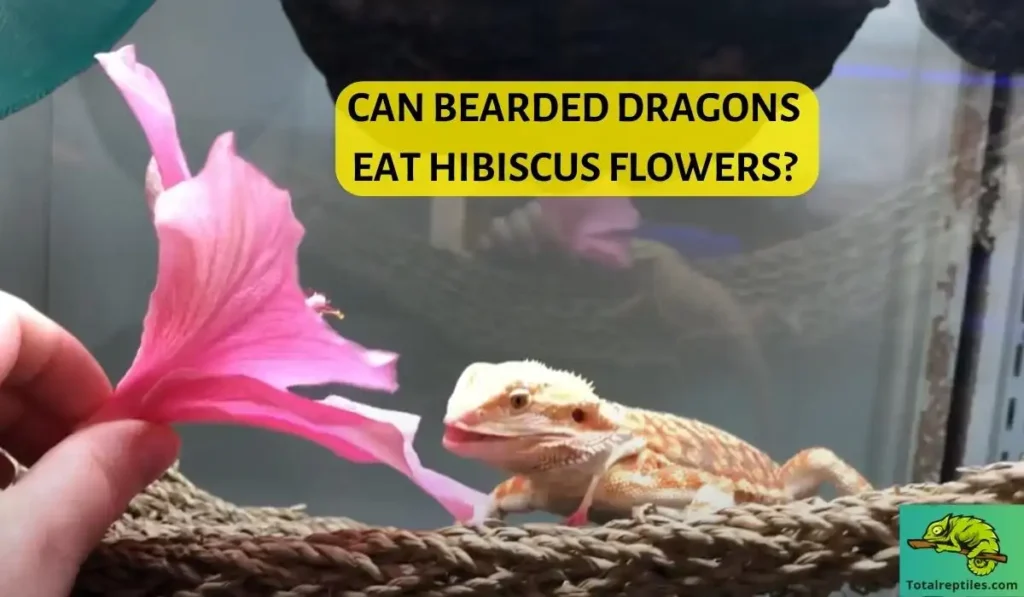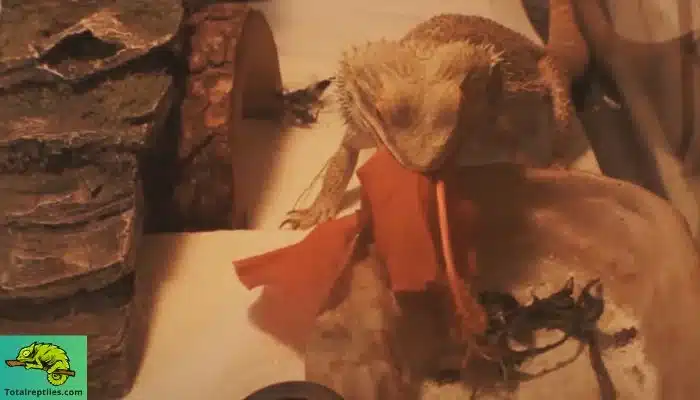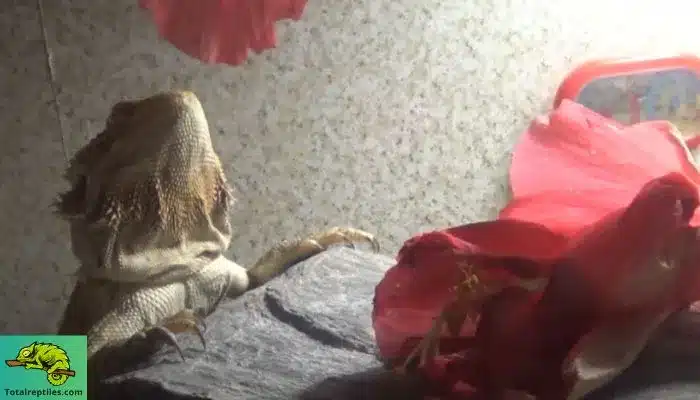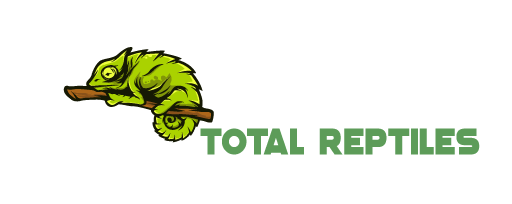You heard it right—bearded dragons can safely enjoy hibiscus flowers. These vibrant blossoms are actually a great choice for these reptilian pets.
The hibiscus plant, belonging to the large genus of plants, offers a variety of options for bearded dragons, some safe and some not.
Species such as the tropical hibiscus and Hibiscus rosa-sinensis are listed as safe choices for your scaly companion.
If you want to add color and nutrition to your bearded dragon’s diet, try hibiscus flowers.

Exploring Hibiscus Flowers
Discover and know more about this vibrant world of these blossoms and their potential benefits for your scaly companion.
Origin:
Hibiscus flowers originate from various regions worldwide, particularly thriving in tropical and subtropical climates. Their striking beauty and alluring fragrance have captivated admirers for centuries, and now we can explore their suitability for bearded dragons.
Types Safe for Bearded Dragons:
Finding hibiscus types that are safe for our scaly pets is important. Some hibiscus species are safe for bearded dragons, but others need more research or veterinary advice.
- Tropical Hibiscus (Hibiscus spp.)
- Hibiscus rosa-sinensis
Potential Food Benefits and Risks of Hibiscus Flowers for Bearded Dragon
Hibiscus flowers offer a range of potential benefits when incorporated into the diet of your bearded dragon. Let’s explore some of these advantages :
Nutritional Value: Hibiscus blossoms provide vitamins, minerals, and antioxidants. They are rich in vitamin C, which boosts the immune system and aids iron absorption.
This flower provides iron, calcium, and magnesium for red blood cells, bone, and muscle health.
The table below shows that hibiscus flower nutrition and health benefits:
| Nutrient | Amount per 100g | Benefits |
|---|---|---|
| Energy | 16 kcal | Provides a source of energy |
| Carbohydrates | 0.89 g | Essential for overall body functions |
| Protein | 2.68 g | Supports growth and muscle development |
| Calcium | 67 mg | Crucial for bone and egg formation |
| Iron | 1.21 mg | Prevents anemia and supports oxygen transport |
| Benefits | ||
| – Nutrient-rich | Offers a variety of essential nutrients | |
| – Hydration | Provides moisture to prevent dehydration | |
| – Digestive Health | Aids in digestion and prevents blockages | |
| – Bone health | Supports strong bones and egg development | |
| – Immune support | Enhances immune system function | |
| – Visual health | Supports good eyesight |
Want to learn more about the bearded dragon diet:
CAN BEARDED DRAGONS EAT FLOWERS?
CAN BEARDED DRAGONS EAT ROSE PETALS?
Antioxidant Properties: Hibiscus flowers are known for their high antioxidant content. Antioxidants reduce oxidative stress and protect cells by neutralizing free radicals.
You can support their overall health and well-being by incorporating hibiscus flowers into your bearded dragon’s diet.
Digestive Health: The fiber content in these flowers can contribute to a healthy digestive system. Adequate fiber intake aids in proper digestion, promotes regular bowel movements, and prevents constipation. Including hibiscus flowers in your bearded dragon’s diet can help maintain their gastrointestinal health.

Hydration Support: This flower can be a valuable source of hydration for bearded dragons. The high water content can prevent dehydration, especially in hot weather or while your pet is recovering from sickness.
Hibiscus blooms are a wet delicacy that might help beardies stay hydrated.
Variety and Enrichment: Introducing hibiscus flowers into your bearded dragon’s diet adds variety and enrichment to their feeding routine.
The vibrant colors and unique flavors of these flowers can stimulate their senses and provide mental stimulation. Offering a diverse range of food options helps prevent dietary monotony and keeps your pet engaged during mealtime.
Highlighting the Potential Risks and Dangers
Hibiscus blossoms can help your bearded dragon, but you must know the risks and dangers. Here are some essential points to consider:
Pesticide Exposure: If sourcing hibiscus flowers from your garden or outside sources, be cautious of pesticide exposure. Pesticides can be harmful to your bearded dragon’s health. Ensure that any flowers offered are not treated with pesticides or other chemicals.
Allergic Reactions: Bearded dragons, like humans, can have allergies or sensitivities to certain plants. Although rare, some individuals may exhibit adverse reactions to hibiscus flowers.
Observe your bearded dragon closely after introducing hibiscus flowers to check for any signs of allergic reactions, such as skin rashes or difficulty breathing.
If you notice any adverse symptoms, discontinue feeding hibiscus flowers and consult a reptile veterinarian.
Unsafe Varieties: Some hibiscus species are safe for bearded dragons but avoid toxic ones.
Hibiscus sabdariffa may not be suited for bearded dragons. Always verify the safety of the specific hibiscus species you intend to feed your pet.
Preparing Hibiscus Flowers For Bearded Dragons – Step By Step
Follow these step-by-step instructions to prepare hibiscus flowers for your scaly friend:

Step-1: Source Fresh Hibiscus Flowers
Choose fresh, organically grown hibiscus flowers for your bearded dragon. Ensure the flowers are not treated with pesticides or other chemicals that could harm your pet.
Step-2: Inspect for Quality
Scrutinize the hibiscus flowers to ensure they are in good condition. Look for vibrant colors, intact petals, and no signs of wilting or decay. Discard any flowers that appear damaged or spoiled.
Step-3: Wash Thoroughly
Rinse hibiscus blossoms under cool, running water to eliminate dirt and pollutants. Gently swish the flowers in a bowl of water to ensure they are clean. Pat them dry with a clean paper towel.
Step-4: Remove Stamens and Pistils
Bearded dragons should not consume the stamens and pistils of hibiscus flowers, as they can be a choking hazard and may cause digestive issues. Carefully pluck out the stamens and pistils from the center of each flower using your fingers or a pair of clean tweezers.
Step-5: Cut into Small Pieces
To help your bearded dragon eat, cut the blossoms into bite-sized pieces. Cut the flowers into manageable chunks with clean kitchen scissors or a sharp knife. Aim for pieces about the size of your bearded dragon’s mouth.
Step-6: Offer as a Treat or Mix with Other Foods
You can offer the prepared hibiscus flower pieces as a standalone treat or mix them with other safe foods in your bearded dragon’s diet. Hibiscus flowers can be added to salads, mixed with greens, or combined with other suitable fruits and vegetables.
Step-7: Monitor Your Bearded Dragon
After introducing hibiscus flowers into your bearded dragon’s diet, closely observe their response and overall health. Pay attention to any signs of allergies, digestive issues, or adverse reactions. If any concerns arise, discontinue feeding hibiscus flowers and consult a reptile veterinarian.
conclusion
Introducing hibiscus flowers into your bearded dragon’s diet can be a flavorful and nutritious treat. These vibrant blooms offer a range of potential benefits that we already mentioned above.
So go ahead and let your bearded dragon enjoy the delightful and healthful goodness of hibiscus flowers!

